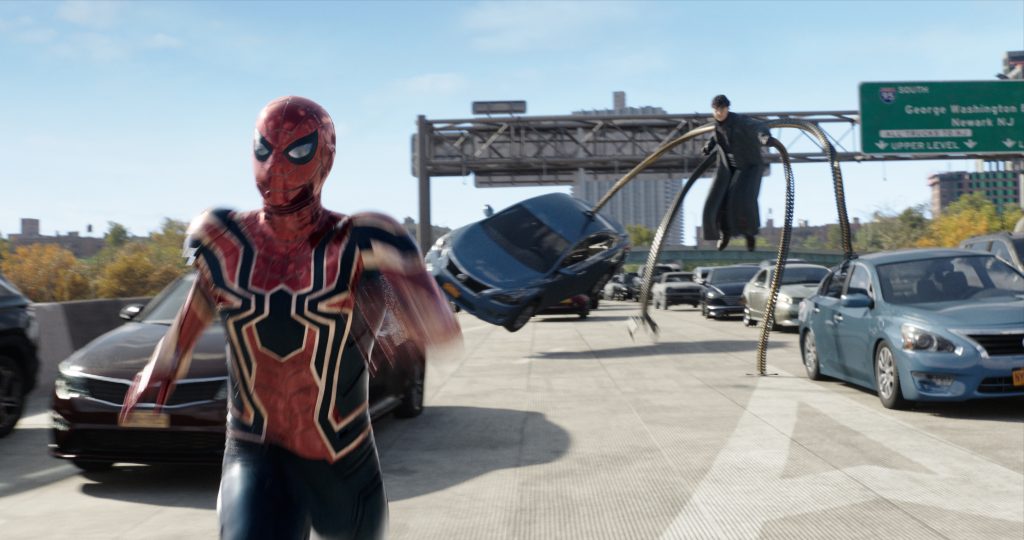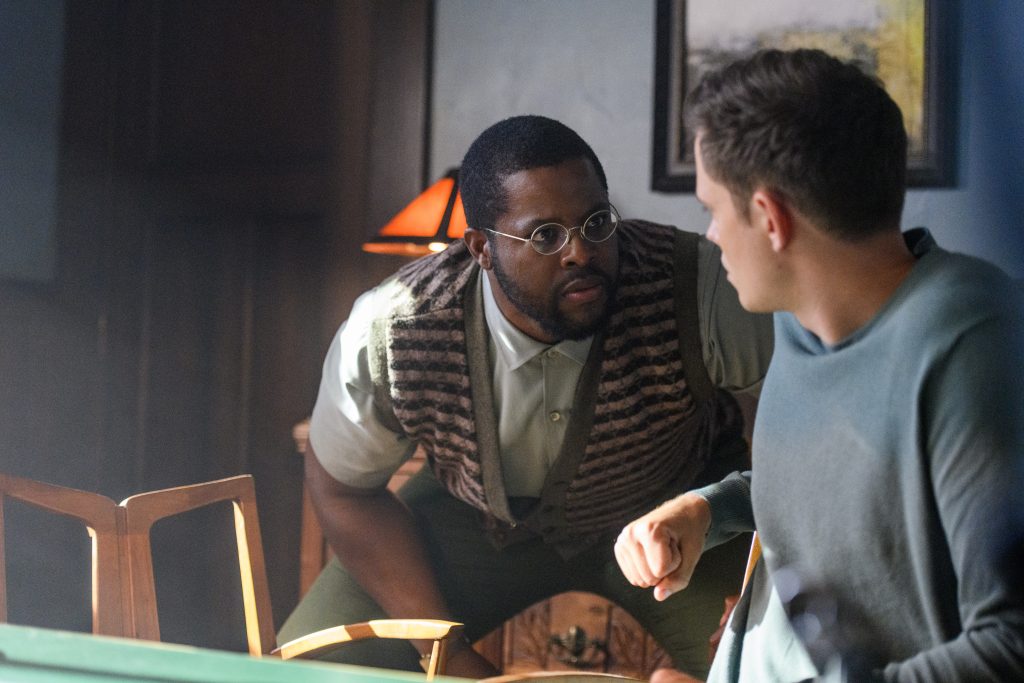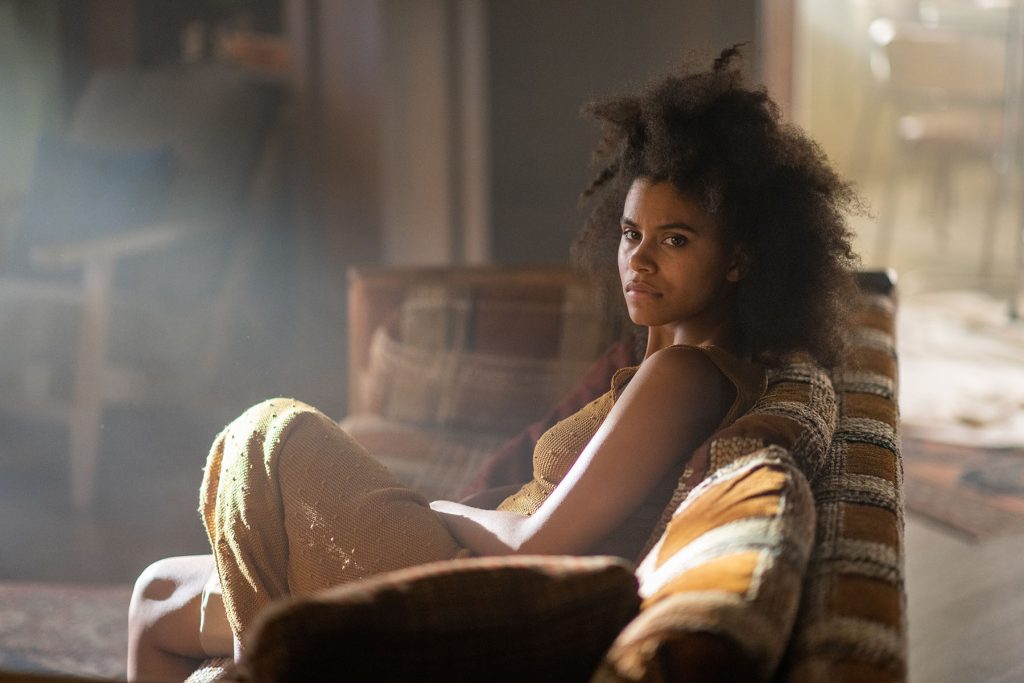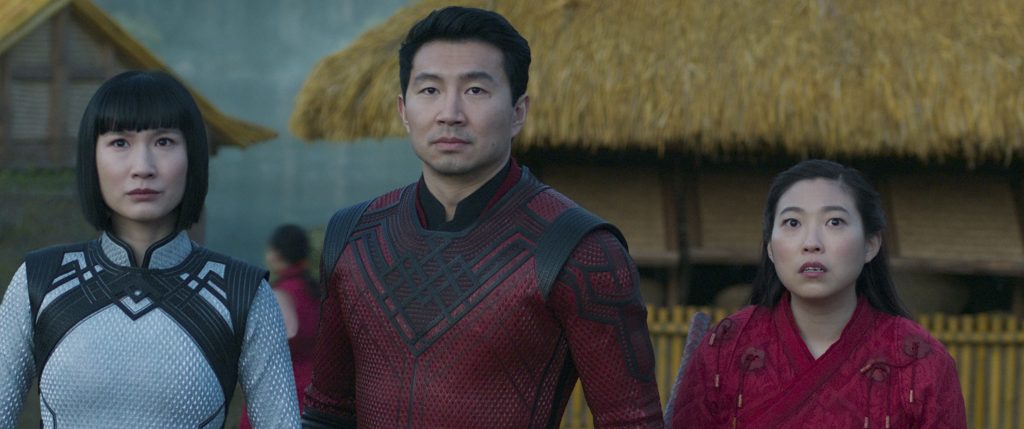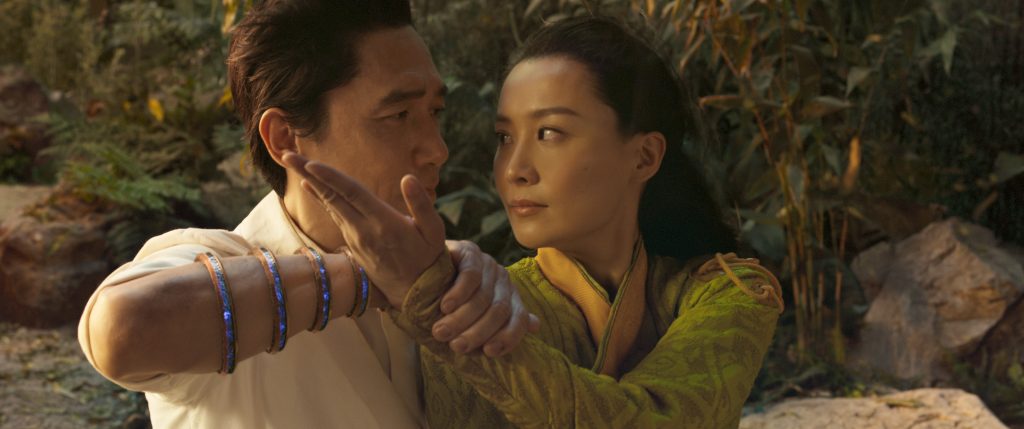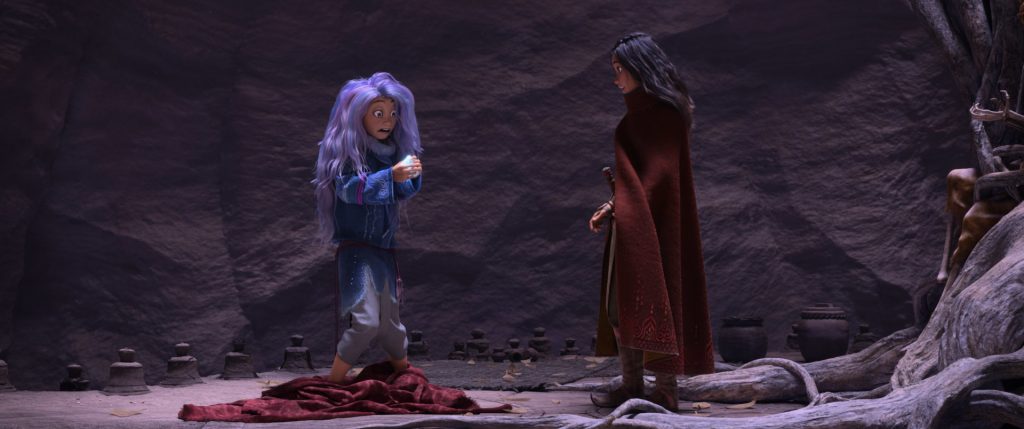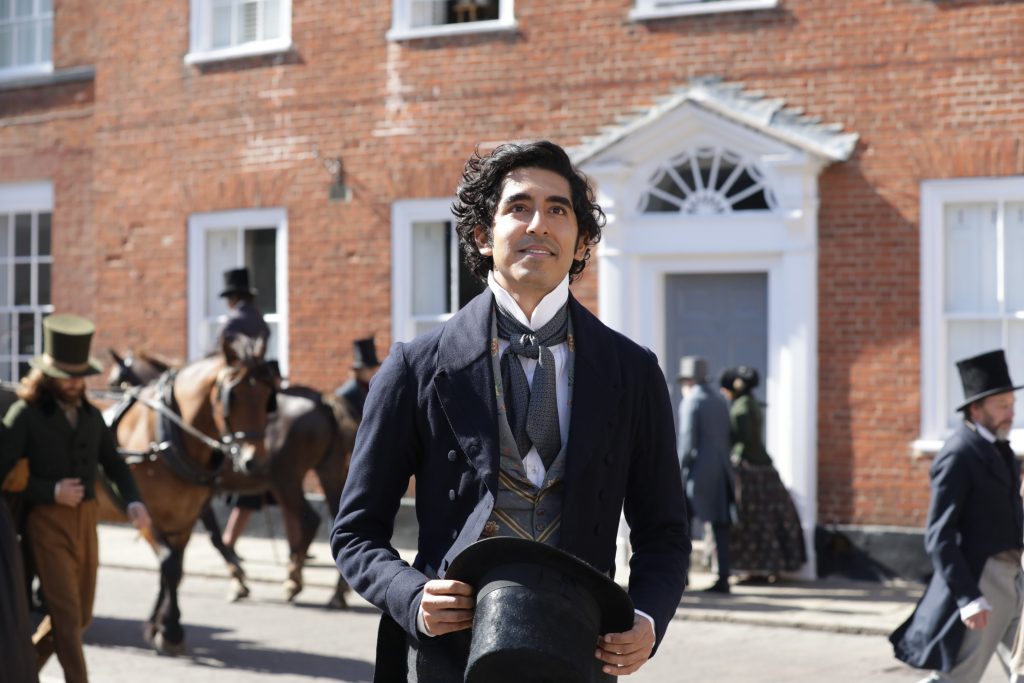May 3, 2022
by Carla Hay

“Doctor Strange in the Multiverse of Madness”
Directed by Sam Raimi
Some language in Spanish with subtitles
Culture Representation: Taking place in New York City and various parts of a multiverse, the superhero action film “Doctor Strange in the Multiverse of Madness” features a predominantly white cast of characters (with a few African Americans, Latinos and Asians) representing the working-class, middle-class and wealthy.
Culture Clash: Superhero sorcerer Doctor Strange, also known as surgeon Stephen Strange, goes on a quest to save teenager America Chavez, who has a special superpower that a villain wants to steal.
Culture Audience: Besides appealing to the obvious target audience of comic book movie fans, “Doctor Strange in the Multiverse of Madness” will appeal primarily to people who are fans of Benedict Cumberbatch, Elizabeth Olsen and the Disney+ superhero series “WandaVision.”

The Marvel Cinematic Universe (MCU) has now become the world’s first cinematic franchise where you need encyclopedia knowledge of certain comic books to know what’s going on and to fully enjoy the movies and TV shows in the franchise. There are many MCU fans who’ve invested years of watching every Marvel movie and every Marvel TV show that comes along. And that investment has its rewards in “Doctor Strange in the Multiverse of Madness.”
But what about people who aren’t die-hard Marvel fans and just want to see a good superhero movie? Simply put: “Doctor Strange in the Multiverse of Madness” is a convoluted but entertaining experience that should not be a viewer’s first MCU movie. It’s a movie that can be considered the tipping point where at least one Marvel show on Disney+ is essential viewing to understand the entire film.
For “Doctor Strange in the Multiverse of Madness,” that essential Marvel show is “WandaVision.” It also helps, but it’s not crucial, to watch the Disney+ animated series “What If…?,” which explored alternate storylines for Marvel characters. If you don’t want to watch any of these Marvel shows, then “Doctor Strange in the Multiverse of Madness” has this message for you: “Too bad, because you will be left behind, and you will feel ignorant about storylines and nuances in any upcoming MCU movies.”
Viewers also need to see (or at least know what happened in) the following movies to fully appreciate “Doctor Strange in the Multiverse of Madness” and its complex plot: 2016’s “Doctor Strange,” 2018’s “Avengers: Infinity War” and 2019’s “Avengers: Endgame.” If you don’t know about the supervillain Thanos or the five-year “disappearance” that he caused, some of the dialogue in “Doctor Strange in the Multiverse of Madness” will not make sense to you. Viewers who have no prior knowledge of any Marvel movie will just be hopelessly lost and will just have to try to enjoy “Doctor Strange in the Multiverse of Madness” for the movie’s high-energy action scenes and compelling visual effects.
The movie’s screenplay, written by Michael Waldron, keeps transporting characters from Multiverse scene to Multiverse scene with such dizzying regularity, the best way to know these characters is by seeing them in previous MCU stories. “Doctor Strange in the Multiverse of Madness” is just like very eye-catching and detailed icing on a cake. It will appeal to many people but be completely unnecessary to others.
Sam Raimi—a filmmaker known for helming the first three “Spider-Man” movies and horror classics such as the first two “Evil Dead” films—directed “Doctor Strange in the Multiverse of Madness” as someone who is clearly an ardent fan of the MCU. But he also directed “Doctor Strange in the Multiverse of Madness” as an ardent fan who expects everyone watching to be all caught up in almost everything related to Marvel on screen prior to the release of “Doctor Strange in the Multiverse of Madness.” And that includes some of the Marvel movies released by the studio formerly known as 20th Century Fox, because some characters from those movies make cameos in “Doctor Strange in the Multiverse of Madness.”
Here are the basic things that people need to know before watching “Doctor Strange in the Multiverse of Madness”: New York City-based superhero sorcerer Doctor Strange, also known as brilliant surgeon Stephen Strange (played by Benedict Cumberbatch), is going on another “good versus evil” quest. Fights and chase scenes ensue. And the “Multiverse” in the MCU is really just another word for “different versions of comic book characters existing in different universes.” After the blockbuster success of 2021’s “Spider-Man: No Way Home,” which had three different versions of Spider-Man interacting with each other in the same movie, there’s no point in being coy about what “multiverse” means if it’s part of a Marvel story.
However, there’s a reason why spoiler-free descriptions of “Doctor Strange in the Multiverse of Madness” are so vague: The movie is filled with more spoilers than a typical superhero film. And those spoilers include describing which characters encounter different versions of themselves in the Multiverse. It should come as no surprise that viewers can expect to see more than one version of Doctor Strange, whose rescue mission in the movie is to save superhero newcomer America Chavez (played by Xochitl Gomez), who’s about 16 or 17 years old, from being robbed of her extremely rare superpower.
What is her superpower? She can travel through the Multiverse with ease. But in this movie, she doesn’t know how to control the power. All she knows is that she can exert this power in moments when she feels extreme fear. America doesn’t know yet that she’s a superhero, so “Doctor Strange in the Multiverse of Madness” can be considered the introduction to her discovering her superhero identity. One of the things that America knows about herself is that she has not found other versions of herself in the Multiverse.
The movie also has a brief flashback to America, when she was about 7 or 8 years old (played by Aliyah Camacho), being separated from her two lesbian mothers—Elena Chavez (played by Ruth Livier) and Amalia Chavez (played by Chess Lopez)—who were involuntarily yanked into a portal that took the mothers into another universe. Ever since then, America has been looking for her mothers, and she fears that her mothers might be dead.
America feels a lot of guilt because she caused that portal to appear after she became frightened by a bee, not knowing that her parents would be taken away from her. In the Marvel comic books, America is openly a lesbian, but her sexuality is not mentioned in “Doctor Strange in the Multiverse of Madness.” She’s too busy running around trying not to get killed to think about dating or having a love interest.
And who exactly is targeting America for her Multiverse superpower? It’s Wanda Maximoff, also known as Scarlet Witch (played by Elizabeth Olsen), a character who is a hero or a villain, depending on which version of this character is in the scene. And because this movie is all about the Multiverse, the Wanda/Scarlet Witch character can sometimes be a hero and a villain in the same scene.
In “Doctor Strange in the Multiverse of Madness,” Wanda is a single mother to fraternal twin boys Billy (played by Julian Hilliard) and Tommy (played by Jett Klyne), who are about 8 or 9 years old. Billy and Tommy have superpowers in “WandaVision” that might or might not be on display in “Doctor Strange in the Multiverse of Madness.” Wanda’s motherhood is crucial to her motivations in almost everything she does in “Doctor Strange in the Multiverse of Madness.” Her motherhood is used as a way for her to manipulate people and how she is manipulated herself.
Viewers who last saw Wanda in 2019’s “Avengers: Endgame” without knowing what happened in “WandaVision” might be utterly confused over when she became a mother. “Doctor Strange in the Multiverse of Madness” explains (in a “WandaVision” spoiler alert) that Wanda/Scarlet Witch used her magical powers to create these children. She quips in response: “That’s what every mother does.” Doctor Strange scolds Wanda/Scarlet Witch for using her magic to mess with reality, which is completely ironic and hypocritical considering what he does later in the movie.
What “Doctor Strange in the Multiverse of Madness” doesn’t explain adequately is why Wanda created these children. The twins were raised by Wanda and her superhero love partner Vision (played by Paul Bettany) up until a certain point in “WandaVision.” People who know what happened in “WandaVision” also know what happened to Vision, which is not explained in “Doctor Strange in the Multiverse of Madness.” What happened in “WandaVision” helps people understand why Wanda, as the Scarlet Witch, has turned to the “dark side,” which in this universe is called the Darkhold, an ancient book of spells.
Don’t expect this movie to have any meaningful “WandaVision” flashbacks to further reveal Wanda’s family situation in “Doctor Strange in the Multiverse of Madness,” but her family motivations are supposed to make her look more sympathetic in doing the things that she does in the movie. It also gives her character more emotional depth to viewers who know her family history, compared to viewers who don’t know. It’s all part of a cross-marketing plan for Disney-owned Marvel Studios to get people to subscribe to Disney+ to watch the Marvel shows on Disney+ so that viewers can fully understand Marvel movies. It’s also called creating viewer FOMO (“fear of missing out”) to full effect.
Certain characters from 2016’s “Doctor Strange” make their return in “Doctor Strange in the Multiverse of Madness.” Stephen’s ex-girlfriend Christine Palmer (played by Rachel McAdams), a surgeon who worked with him at the same hospital, gets married to a man named Charlie (played by Ako Mitchell), who is a fan of Doctor Strange. Stephen is invited to the wedding, where he privately tells Christine that he regrets not trying harder for them to stay together. (They broke up because he’s a workaholic and because all those superhero duties got in the way.)
Christine responds, “Stephen, it was never going to work out between us. Because you were always going to be the one holding the knife. I could respect you for it, but I could never love you for it.” And there are more heartbroken and emotionally wounded moments for Stephen/Doctor Strange in the movie, with some of those moments involving Christine.
Doctor Strange’s loyal superhero colleague Wong (played by Benedict Wong) also makes his return. Wong is now the Sorcerer Supreme, who oversees sorcerer training in Kamar-Taj, which is located in another dimension. Doctor Strange and Wong fight side by side in some scenes, but there’s a stretch of the movie where Doctor Strange and Wong are not in the same universe and have to fight separate battles. There’s no story arc for steadfast and dependable Wong in “Doctor Strange in the Multiverse of Madness,” which is a missed opportunity, because Wong deserves to have more character development in the MCU.
Also returning is Karl Mordo (played by Chiwetel Ejiofor), who became an enemy of Doctor Strange in the first “Doctor Strange” movie, but Mordo might or might not have the same type of personality or life story in other parts of the Multiverse. Dr. Nicodemus “Nic” West (played by Michael Stühlbarg), the surgeon who operated on Stephen’s hands after Stephen was in a near-fatal car accident in the first “Doctor Strange” movie, makes a brief appearance (less than five minutes) in “Doctor Strange in the Multiverse of Madness,” where Dr. West is a guest at Christine’s wedding. In this scene, Dr. West sits next to Stephen and smugly tells Stephen that although Doctor Strange likes to think that he is the “best surgeon and the best superhero,” in the end, Stephen/Doctor Strange “didn’t get the girl.”
Other than America Chavez, “Doctor Strange in the Multiverse of Madness” doesn’t do much with new characters in the MCU. These new MCU characters include mystic artists Sara (played by Sheila Atim) and Rintrah (played by Adam Hugill), who are both disciples of Wong in Kamar-Taj. The purpose for Sara and Rintrah in the movie is exactly what you think it might be in forgettable roles. As far as introducing new characters, “Doctor Strange in the Multiverse” is all about making America Chavez a newcomer star of the MCU.
Scarlet Witch is the movie’s main villain, but there are some monsters that also cause mayhem. One of them is a giant one-eyed octopus that appears during Christine’s wedding. It’s a somewhat awkwardly staged scene, where the octopus suddenly appears on the streets of New York City, and Doctor Strange quickly puts on his magical cloak (don’t call it a “cape,” according to him) and jumps off of a balcony to fight the monster. Some generic-looking demons also make appearances during the fight scenes.
Visually, the movie has its dazzling moments. In terms of its story, “Doctor Strange in the Multiverse of Madness” is a mixed bag. At times, it gets repetitive and jumbled as you think it can be when people jump through portals and enter different universes during chase scenes. And that’s not the only repetition: “Doctor Strange in the Multiverse of Madness” repeats the MCU formula of superheroes making wisecracking jokes during action scenes. There are also parts of the movie that repeat a scenario where someone has to “prove” their identity and show evidence that what they’re saying is the truth, because the Multiverse is supposed to make people feel disoriented about what’s real and what isn’t real.
The movie also repeats a theme of the main characters looking for their definition of happiness. More than once in “Doctor Strange in the Multiverse of Madness,” someone is asked, “Are you happy?” And then it’s followed up with some version of saying, “Are you really happy? Don’t lie to me because I can tell you’re not really happy.” Is this a superhero movie or a therapy session?
Other times, the movie works very well when it comes to laying the groundwork for developing the story of America Chavez and how she became an ally of Doctor Strange and Wong. Some horror movie elements kick into high gear in the last third of “Doctor Strange in the Multiverse of Madness,” which handles horror better than 2022’s “Morbius” movie, the origin story of Marvel’s vampire anti-hero Morbius. Raimi’s experience as a horror filmmaker greatly benefits “Doctor Strange in the Multiverse of Madness.”
There’s nothing really spectacular about any of the acting in “Doctor Strange in the Multiverse of Madness,” but the acting isn’t terrible either. Stephen Strange/Doctor Strange is known for his arrogance and impatience, but in “Doctor Strange in the Multiverse of Madness,” he shows more humility and emotional vulnerability than in previous Marvel movies, and Cumberbatch plays the part accordingly. McAdams doesn’t have a lot to work with for her Christine character, who has a stereotypical action movie role of an ex-girlfriend thrown back into an ex-boyfriend’s life so she can be in the action scenes too.
Olsen is very good in her role as Wanda Romanoff/Scarlet Witch, but she was better in “WandaVision,” which required her to show a wider range of personalities in vastly different scenarios. Viewers’ reactions will largely depend on how emotionally connected they feel to Wanda Romanoff/Scarlet Witch, considering she has presented many different sides of herself in the MCU. Gomez portrays America with credibility as someone who is an awkward, slightly rebellious teenager who feels like a lost soul. She and Doctor Strange eventually learn to trust and respect each other, but their clashes just retread the “smart-alecky kid paired with a reluctant adult mentor” formula that’s been in many other movies.
The most emotional moments in”Doctor Strange in the Multiverse of Madness” will have the greatest resonance with people who’ve seen “WandaVision” and the aforementioned MCU movies. Everything that has to do with Wanda/Scarlet Witch can best be understood by people who know what happened in “WandaVision.” And when you need to watch a TV series first to understand a movie’s chief villain, that could be a problem for “Doctor Strange in the Multiverse of Madness.”
“Doctor Strange in the Multiverse of Madness” also has the expected mid-credits/end-credits scenes that tease what will happen in other movies or TV shows that are part of the MCU franchise. Charlize Theron is in the mid-credits scene as a character who becomes a very important part of Doctor Strange’s life, based on this character’s Marvel Comics storyline. The movie’s end-credits scene is a throwaway joke that has no bearing on subsequent storylines, but it’s a reference to a spell that was cast on someone in “Doctor Strange in the Multiverse of Madness.” Some of the “surprise” cameos just further establish that certain franchise characters that were kept separate from the MCU have now become a part of the MCU.
If you yearn for a time when watching a new superhero movie sequel didn’t have to entail seeing at least three other movies in the franchise and possibly a TV series related to the franchise, in order to understand what happens in the sequel you’re watching, then get used to this MCU reality, because that simpler time is over. Also long gone are the days when having a maximum of five superheroes in a movie sequel was considered too much. Nowadays, not only has the MCU raised expectations for each MCU movie sequel to have numerous superheroes (as main characters and as cameos), but “Doctor Strange in the Multiverse of Madness” has also ensured that viewers can expect different versions of these superheroes to pop up at any time. It’s a superhero party for superfans, but regular fans or casual fans will feel like they’re at a party where only certain people understand the inside jokes.
Disney’s Marvel Studios will release “Doctor Strange in the Multiverse of Madness” in U.S. cinemas on May 6, 2022. Disney+ will premiere the movie on June 22, 2022.


